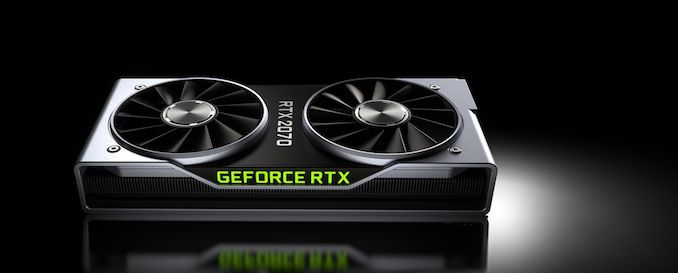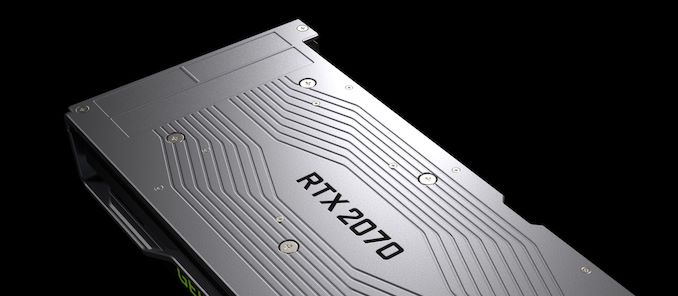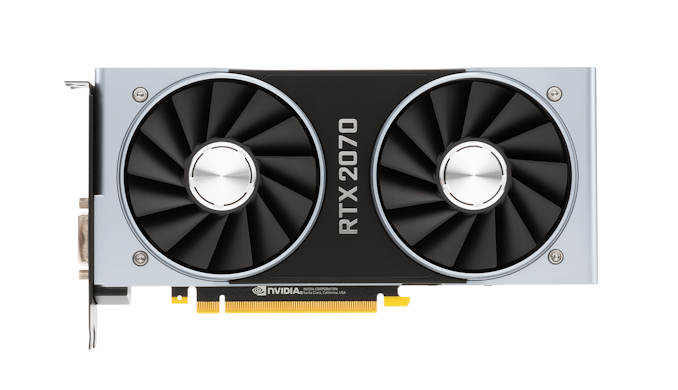The NVIDIA GeForce RTX 2070 Founders Edition Review: Mid-Range Turing, High-End Price
by Nate Oh on October 16, 2018 9:00 AM ESTFinal Words
As we wrap up, it’s clear that judging the RTX 2070 involves the same themes that surfaced in the RTX 2080 Ti and 2080 review. First is for the forward-looking featuresets that have yet to publicly launch. Another, and closely intertwined, is the premium pricing that is based on those features, as opposed to being based on conventional gaming performance. And lastly is the existing competition in the form of Pascal, especially where the RTX cards fall in the same performance tier.
For the RTX 2070 Founders Edition, those themes are more relevant and harder to dismiss. By its nature, the card is an entry-level model for consumers interested in real time raytracing and other RTX platform features, as well as the traditional high-end card for prospective enthusiasts and upgraders on a budget. In the past couple generations, these ‘enthusiast value’ parts have essentially provided last-gen flagship performance (or better), at non-flagship prices. For example:
- GTX 1070 for GTX 980 Ti
- GTX 970 for GTX 780 Ti
- GTX 770 refresh of GTX 680
- RX 580/480 for R9 390
- R9 390 refresh of R9 290
- R9 280X refresh of HD 7970
Going back to the numbers, the RTX 2070 Founders Edition TDP and boost clock tweaks only amount to around a 4% gain over the reference 2070 at 4K. The difference is not much in the grand scheme of things, but the setup makes more sense when looking at the GTX 1080 competition. The reference RTX 2070 is faster than the GTX 1080 at 4K and 1440p by only around 10%, a gap that is easily closed by factory-overclocked custom cards.
By hardware resources, the RTX 2070 was expected to be around 75% of the 2080. But Founders-to-Founders and reference-to-reference, the RTX 2070 is bringing around 83% of the RTX 2080’s 1440p performance (and 82% of 4K performance). So the performance gap is comparable to previous generations, where the GTX 1070 brought 81% of the performance of the GTX 1080, and the GTX 970 brought 87% of the GTX 980. Except here the RTX 2080 is only managing GTX 1080 Ti level performance for traditional gaming.
Looking back at the Pascal launch, the GTX 1070 brought a 57% 1440p performance gain over GTX 970, which was substantive but with its $450 Founders Edition pricing, not necessarily a must-buy for GTX 970 owners. On the other hand, GTX 770/670 owners had a lot to gain from that upgrade.
Here with Turing, the RTX 2070 is ahead of the GTX 1070 reference-to-reference around 35% and 36% at 1440p and 4K, respectively. In its Founders Edition guise, the difference is around 41% for both resolutions. Either way, the performance lies somewhere between the GTX 1080 and 1080 Ti, except with a $600 Founders Edition price. In that sense, it offers less than last generation but at a higher price, the premium being tied to real time raytracing and other hardware-accelerated features. And when those features finally release, there's no clear sense of the quality or resolution compromises necessary to run those features.
For current GTX 10 series owners, the RTX 2070 is largely a side-grade, offering known performance for possibily worse power efficiency. For those with low-end cards, or 900 series and older products, the $500/$600 budget pulls in a number of other alternatives: the GTX 1080, RX Vega 64, or even the GTX 1070 Ti. As far as standard $500 MSRP pricing goes, for which some cards are priced so currently, it helps the RTX 2070 stay in the price/performance race, where at $600 that might be a $100+ premium over a competing product. In particular, the sub $500 GTX 1080 cards are a major spoiler for the RTX 2070, offering equivalent performance at lower price. A prospective RTX 2070 buyer will have to be honest with themselves on utilizing RTX features when the time comes, and any intentions they might have on upgrading monitors for HDR, higher resolution and/or refresh rate, and variable refresh rate technology.













121 Comments
View All Comments
Jon Tseng - Tuesday, October 16, 2018 - link
Anandtech review out on time? What is the world coming to???MrSpadge - Tuesday, October 16, 2018 - link
That was a nate review. Ehm, I mean neat.ianmills - Tuesday, October 16, 2018 - link
Oh, I get it!bug77 - Wednesday, October 17, 2018 - link
Oh, nate! I mean, oh neat!dollarshort - Tuesday, October 16, 2018 - link
Technically a day late if you count Kyle B's review ;)Jon Tseng - Tuesday, October 16, 2018 - link
BUT I WANT MY REVIEWS TO HAVE LOTS OF EGREGIOUS TECHNICAL DETAIL AND DROP 2 WEEKS LATE! :-pimaheadcase - Tuesday, October 16, 2018 - link
Apparently its come to flying around the globe to tech conferences, reporting on news than actual product.mkaibear - Tuesday, October 16, 2018 - link
Waa! Waa! My free entertainment isn't exactly what I want it to be, time to get on my keyboard and complain about it.Grow up. Or go elsewhere. Anandtech is doing a great job given the constraints they operate under.
Diji1 - Wednesday, October 17, 2018 - link
Waa! Waa! This comment isn't exactly what I want it to be, time to get on my keyboard and complain about it.Grow up. Or go elsewhere. imaheadcase is doing a great job given the constraints they operate under.
GreenReaper - Thursday, October 18, 2018 - link
Like... being a headcase? >_>Sometimes the flying is part of getting the product to review. Other times... well, trade shows and the like are sometimes compensation for the level of pay provided by an online news reporting gig. This isn't the glory days of Personal Computer World, with issues 600-pages thick with ads.